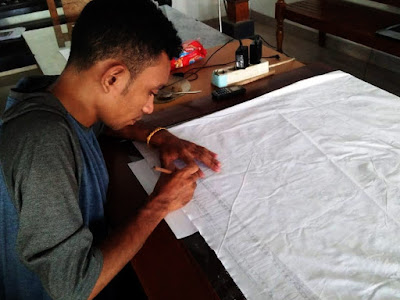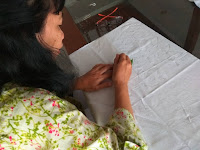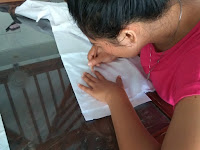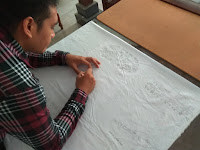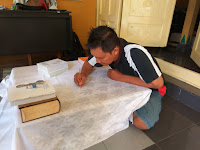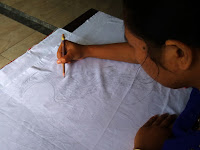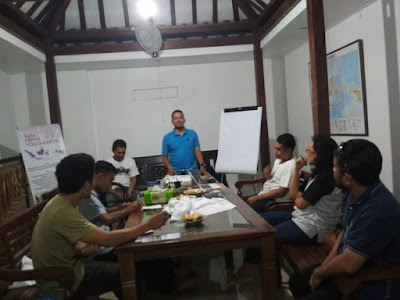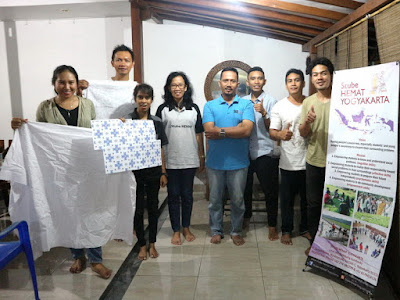Finding out batik motif and its philosophy
Thursday, 29 November 2018by adminstube
Feeling proud to have batik recognized as world cultural heritage from Indonesia encourages Stube-HEMAT team to involve and learn more about it. The sensation of designing batik motifs on cloth while learning the philosophical meaning of the motif is like a stimulating addiction to keep working on every sheet till it is finished. Everyone is proud of its beauty and uniqueness of the motif designs that show local wisdom of the origin.
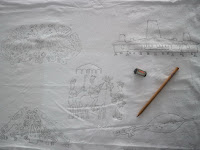 Those motifs that the team are proud of, have various styles, such as leaves and passion fruit that mean growing to shade because these plants can grow quickly, live anywhere, and their thick leaves can be used as shade and protectors from sun light, while the fruits contain vitamins. The tamarind leaf motif, which is Javanese 'tamarind' has a meaning of making people 'interested' or happy to see it. The team originating from Sumba promoted its local motifs, such as Cockatoos, Parrots, traditional house and Mamuli, iconic item used by Sumbanese as ‘belis’ (dowry) for marriage. Cockatoos and parrots symbolize sense of togetherness and brotherhood besides their unique chirps. While the motifs of yellow chest hornbills and angelbirds were drawn by team from Halmahera. Hornbills are indigenous birds that are respected in East Halmahera and Angelbirds are rare birds because they only exist in North Halmahera. Never miss the design of whale motif and ‘Tatong’, traditional musical instruments drawn by team from Lembata.
Those motifs that the team are proud of, have various styles, such as leaves and passion fruit that mean growing to shade because these plants can grow quickly, live anywhere, and their thick leaves can be used as shade and protectors from sun light, while the fruits contain vitamins. The tamarind leaf motif, which is Javanese 'tamarind' has a meaning of making people 'interested' or happy to see it. The team originating from Sumba promoted its local motifs, such as Cockatoos, Parrots, traditional house and Mamuli, iconic item used by Sumbanese as ‘belis’ (dowry) for marriage. Cockatoos and parrots symbolize sense of togetherness and brotherhood besides their unique chirps. While the motifs of yellow chest hornbills and angelbirds were drawn by team from Halmahera. Hornbills are indigenous birds that are respected in East Halmahera and Angelbirds are rare birds because they only exist in North Halmahera. Never miss the design of whale motif and ‘Tatong’, traditional musical instruments drawn by team from Lembata.
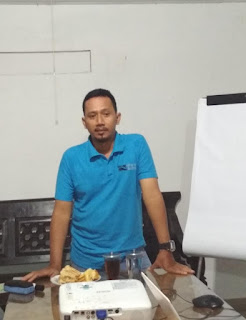 The motives that have been drawn on piece of cloth then were discussed in the workshop accompanied by Heru Santoso, a batik practitioner, on Friday 11/23/2018 at 6:00-8.00pm at Stube-HEMAT Yogyakarta secretariat. After discussing the Batik results done by the team, the workshop was the first debriefing on batik process. In his presentation, Heru Santoso explained three types of batik, namely written batik, stamp and written combination and stamp. As time went on, new types of batik emerged, such as Sibori, Jumput, Celup, Colet, and Ecoprint. Batik itself is indeed a process of hindering colors on the fabric to produce motifs, whether using wax, folds or twists. "Actually, there are unique batik abroad, however only batik and motifs from Indonesia are considered interesting and unique with high level of complexity so that they are appreciated more," he explained.
The motives that have been drawn on piece of cloth then were discussed in the workshop accompanied by Heru Santoso, a batik practitioner, on Friday 11/23/2018 at 6:00-8.00pm at Stube-HEMAT Yogyakarta secretariat. After discussing the Batik results done by the team, the workshop was the first debriefing on batik process. In his presentation, Heru Santoso explained three types of batik, namely written batik, stamp and written combination and stamp. As time went on, new types of batik emerged, such as Sibori, Jumput, Celup, Colet, and Ecoprint. Batik itself is indeed a process of hindering colors on the fabric to produce motifs, whether using wax, folds or twists. "Actually, there are unique batik abroad, however only batik and motifs from Indonesia are considered interesting and unique with high level of complexity so that they are appreciated more," he explained.
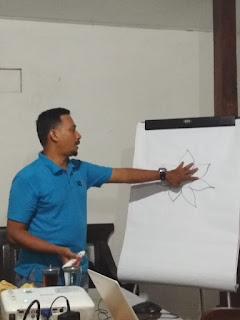 Main pattern is needed in drawing motif and then its edge is decorated with a fringe pattern and the rest is added by ‘isen-isen’ or fillings on the blank part of the fabric, in order to beautify overall motif. As a note, the Stube team members are beginner, it is recommended to make a bigger motif, to make it easier when the process of 'canting'. Sometimes, motifs of bird, fish or human needed to be disguised without eliminating the essence of the motif, or called Stylation process, because basically batik is different from painting so the motif does not have the same details. That is the aesthetic value of a motif.
Main pattern is needed in drawing motif and then its edge is decorated with a fringe pattern and the rest is added by ‘isen-isen’ or fillings on the blank part of the fabric, in order to beautify overall motif. As a note, the Stube team members are beginner, it is recommended to make a bigger motif, to make it easier when the process of 'canting'. Sometimes, motifs of bird, fish or human needed to be disguised without eliminating the essence of the motif, or called Stylation process, because basically batik is different from painting so the motif does not have the same details. That is the aesthetic value of a motif.
There are several ways of colouring batik. Naptol (Naphtalene) is used in dying method and ‘Colet method’ is used to get various colours with Remasol colouring and brush to block the motif.
This small workshop enlightened all Stube team member in designing motifs and color selection. Hopefully the next process of making batik will run well and produce unique works. Have nice process. (ML).
Web Archive
2025 (20) 2013 (20)
2012 (12)
2011 (2)
2010 (18)
Total: 488
Youtube Channel
Lebih baik diam dari pada Berbicara Tetapi tidak ada Yang Di pentingkan Dalam Bicaranya
-->
